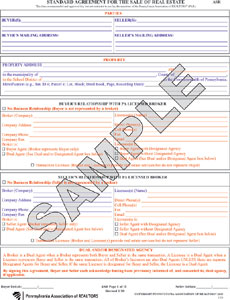

Where have you seen this language before? At the bottom of your MLS sheets, of course.
Why is this language there? It’s easy to make a mistake regarding the taxes, square footage, zoning or any detail of a property that can be mistakenly transcribed or just plain wrong. This simple statement gives sellers and listing agents a little wiggle room.
So, who is legally responsible when a buyer relies (to his detriment) on a flawed MLS Sheet? The answer depends on the agreement of sale and any modifications made to that agreement. It also depends on the specific facts of the transaction in question.
Simply put, an unmodified Standard Agreement puts the risk that MLS information may be wrong squarely on the buyer.
PAR’s standard agreements are integrated contracts. An integrated contract incorporates all terms and conditions of the agreement into the final written document. PAR’s Standard Agreement for the Sale of Real Estate (Form ASR) reads this way: REPRESENTATIONS: All representations, claims, advertising, promotional activities, brochures or plans of any kind made by Seller, Brokers, their licensees, employees, officers or partners are not part of this Agreement unless expressly incorporated or stated in this Agreement (emphasis added). Certainly the information stated on an MLS Sheet would fall into one of the categories that this language excludes as a term of the contract.
The PAR Standard Agreement of Sale integration clause has real — not imaginary — teeth. Consider the buyer who reads in the MLS that the home is 3,600 square feet. What recourse does this buyer have when, after settlement, he determines that the actual square footage is closer to 2,800 square feet? If the agreement makes no reference to the square footage of the home, the buyer will have no recourse. After all, the contract specifically states that it “. . . contains the whole agreement between Seller and Buyer, and there are no other terms, obligations, covenants, representations . . .” The size of the home was not warranted nor even a term of the agreement that can be enforced.
Pennsylvania evidentiary rules will not permit the buyer to introduce into evidence at a trial the fact that the MLS represented the square footage that the buyer relied on. The Parol Evidence Rule prohibits a party to an integrated contract from presenting evidence that contradicts or adds to the terms of the written contract.
Because we use an integrated contract to protect the seller from MLS errors, why do we need the language found at the bottom of each MLS page? This language, albeit a mixed message, serves as a reminder to buyer agents that due diligence is needed. In a civil lawsuit, the Parol Evidence Rule would protect the broker because it establishes that the buyer did not rely on the misrepresentation found in the MLS.
Does this simple phrase protect a listing agent from an ethics claim that the listing broker misrepresented a pertinent fact? In an ethics claim, the Parol Evidence Rule offers no defense. A misrepresentation is a misrepresentation — whether or not the buyer can prove that he actually relied on that misrepresentation. Whether the words “not guaranteed” will protect the listing broker from such an ethics claim can’t be answered here with any certainty; only an ethics hearing panel can make that determination. The better course is evident: keep your facts straight when putting data in the MLS.
Successfully defending a civil suit claiming misrepresentation in the MLS should not be your objective. Winning is great — but avoiding suits and ethics claims altogether is even better. To the best of your ability, input only accurate information into the MLS. For some information you will frequently rely on the seller’s representations. When that is the case, why not have the seller sign a copy of the input sheet or a printout of the MLS once it is published? Have the seller review the MLS information and send you an email indicating that she reviewed it in its entirety and that it is accurate. Print this email and put it in your file.
(I once represented a commercial licensee who was sued for having represented that a liquor license would be sold with the restaurant. When the license could not be obtained, the buyer sued not only the seller but the listing broker. This listing broker had the foresight to have the seller sign an MLS sheet to indicate that the information, including the statement that the license was included, was accurate. He won.)
If the integration clause serves to protect a seller from liability arising from the inaccuracy of pre-contract representations, advertisements and the like, what is its impact on a buyer? As you can imagine, a buyer who relies on statements and written materials, whether issued by the seller or broker, is at risk if these representations prove inaccurate. More succinctly stated, a buyer cannot rely on representations, even those in the MLS, unless the specific representations are included as a term in the agreement of sale. If the seller represents that the property consists of 30 acres, why not transpose that promise from the MLS to the agreement of sale: “Seller represents and warrants that the quantum of land to be conveyed is 30 acres; this warranty to survive settlement.”
If the seller refuses to permit the incorporation of a representation as a term in the agreement of sale, then what’s the worth of that representation? If the seller refuses to incorporate a representation as a term of the agreement, it underscores the need for the buyer to engage in due diligence. When a buyer agent allows a buyer to rely on out-of-contract representations, then the buyer is at risk — and in turn the buyer agent is at risk for malpractice. As a buyer agent, you cannot allow your buyer to rely on a pre-agreement representation and then immediately turn around and have your client sign a contract stating that the buyer does not rely on pre-agreement representations!
In short, if your buyer is relying on the MLS Sheet, the seller disclosure form or even a marketing brochure to make his decision to buy, make sure you include these representations in the agreement.
Topics
Member Discussion
Recent Articles
-
Seller’s Property Disclosure: From the Buyer’s Side
- May 9, 2025
- 4 min. read
A lot of education about the Seller’s Disclosure Law is about a seller’s responsibilities. But what are some things that buyers (and their agents) should be taking into consideration when reviewing the Seller’s Property Disclosure Statement?
-
1 in 3 Underestimate Energy Upgrade Costs
- May 8, 2025
- 2 min. read
Despite the cost of energy-efficient upgrades, 90% of those surveyed said they didn’t regret their decision to make them.
-
Home Insurance Rates Rose for 2 in 3 Policyholders in 2024
- May 7, 2025
- 2 min. read
From 2023 to 2024, the majority (35%) said their home insurance rates increased by 5.0% to 9.9%. A considerable 21% said their rates rose 10.0% to 19.9%.
Daily Emails
You’ll be the first to know about real estate trends and various legal happenings. Stay up-to-date by subscribing to JustListed.



